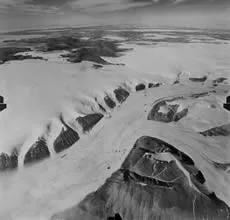Cryosphere glossary
icebound
a harbour, inlet, etc, is said to be icebound when navigation by ships is prevented due to ice, except possibly with the assistance of an icebreaker.
icefall
part of a glacier with rapid flow and a chaotic crevassed surface; occurs where the glacier bed steepenes or narrows.
Image

Icefalls on three parallel glaciers.
Tom Lowell, University of Cincinnati
icefield
a mass of glacier ice; similar to an ice cap, and usually smaller and lacking a dome-like shape; somewhat controlled by terrain.
Image

Kalstenius Icefield, located on Ellesmere Island, Canada, shows vast stretches of ice. The icefield produces multiple outlet glaciers that flow into a larger valley glacier. The glacier in this photograph is three miles wide.
Royal Canadian Air Force, archived at the World Data Center for Glaciology, Boulder, CO
icefoot
a narrow fringe of ice attached to the coast, unmoved by tides and remaining after the fast ice has broken free.
Icelandic low
the low pressure center near Iceland (mainly between Iceland and southern Greenland); on mean charts of sea-level pressure, it is a principal center of action in the atmosphere circulation of the northern hemisphere.
iceport
an embayment in an ice front, often of temporary nature, where ships can moor alongside and unload directly into the ice shelf.
icicle
hanging spike of clear ice formed by the freezing of dripping water.
iciness
a qualitative term describing the quantity of ice in frozen ground.
icing
a sheetlike mass of layered ice formed on the ground surface, or on river or lake ice, by freezing of successive flows of water that may seep from the ground, flow from a spring or emerge from below river or lake ice through fractures.
icing blister
a seasonal frost mound consisting only of ice and formed at least in part through lifting of one or more layers of an icing by injected water.
icing glade
an area kept clear of trees and shrubs by the annual occurrence of icings.
icing mound
a seasonal frost mound consisting exclusively of thinly layered ice, formed by freezing of successive flows of water issuing from the ground or from below river ice.
inactive ice wedge
an ice wedge that is no longer growing.
inactive rock glacier
a mass of rock fragments and finer material, on a slope, that contains either an ice core or interstitial ice, and shows evidence of past, but not present, movement.
infrared radiation
electromagnetic radiation of wavelengths between approximately 0.75 and 1000 millimeters; see also atmospheric radiation, terrestrial radiation, longwave radiation.
inland ice sheet
an ice sheet of considerable thickness and an area of more than about 50,000 square kilometers (12.4 million acres), resting on rock; inland ice sheets near sea level may merge into ice shelves.
insolation
(1) exposure of an object to the sun (2) intensity of incoming solar radiation incident on a unit horizontal surface at a specific level.
instrument shelter
structure to protect certain instruments from insolation and weather while at the same time ensuring sufficient ventilation.
interfacial water
water that forms transition layers at mineral/water and mineral/water/ice interfaces in frozen ground.
intermediate discontinuous permafrost
(1) (North American usage) permafrost underlying 35 - 65% of the area of exposed land surface (2) (Russian usage) permafrost underlying 40 - 60% of the area of exposed land surface.